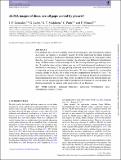ALMA images of discs : are all gaps carved by planets?
Abstract
Protoplanetary discs are now routinely observed and exoplanets, after the numerous indirect discoveries, are starting to be directly imaged. To better understand the planet formation process, the next step is the detection of forming planets or of signposts of young planets still in their disc, such as gaps. A spectacular example is the Atacama Large Millimeter/submillimeter Array (ALMA) science verification image of HL Tau showing numerous gaps and rings in its disc. To study the observability of planet gaps, we ran 3D hydrodynamical simulations of a gas and dust disc containing a 5 MJ gap-opening planet and characterized the spatial distribution of migrating, growing and fragmenting dust grains. We then computed the corresponding synthetic images for ALMA. For a value of the dust fragmentation threshold of 15 m s−1 for the collisional velocity, we identify for the first time a self-induced dust pile-up in simulations taking fragmentation into account. This feature, in addition to the easily detected planet gap, causes a second apparent gap that could be mistaken for the signature of a second planet. It is therefore essential to be cautious in the interpretation of gap detections.
Citation
Gonzalez , J-F , Laibe , G , Maddison , S T , Pinte , C & Ménard , F 2015 , ' ALMA images of discs : are all gaps carved by planets? ' , Monthly Notices of the Royal Astronomical Society: Letters , vol. 454 , no. 1 , pp. 36-40 . https://doi.org/10.1093/mnrasl/slv120
Publication
Monthly Notices of the Royal Astronomical Society: Letters
Status
Peer reviewed
ISSN
1745-3925Type
Journal article
Description
This research was partially supported by the Programme National de Physique Stellaire and the Programme National de Planétologie of CNRS/INSU, France. JFG thanks the LABEX Lyon Institute of Origins (ANR-10-LABX-0066) of the Université de Lyon for its financial support within the programme ‘Investissements d'Avenir’ (ANR-11-IDEX-0007) of the French government operated by the ANR. GL is grateful for funding from the European Research Council for the FP7 ERC advanced grant project ECOGAL. STM acknowledges the support of the visiting professorship scheme from Université Claude Bernard Lyon 1.Collections
Items in the St Andrews Research Repository are protected by copyright, with all rights reserved, unless otherwise indicated.

